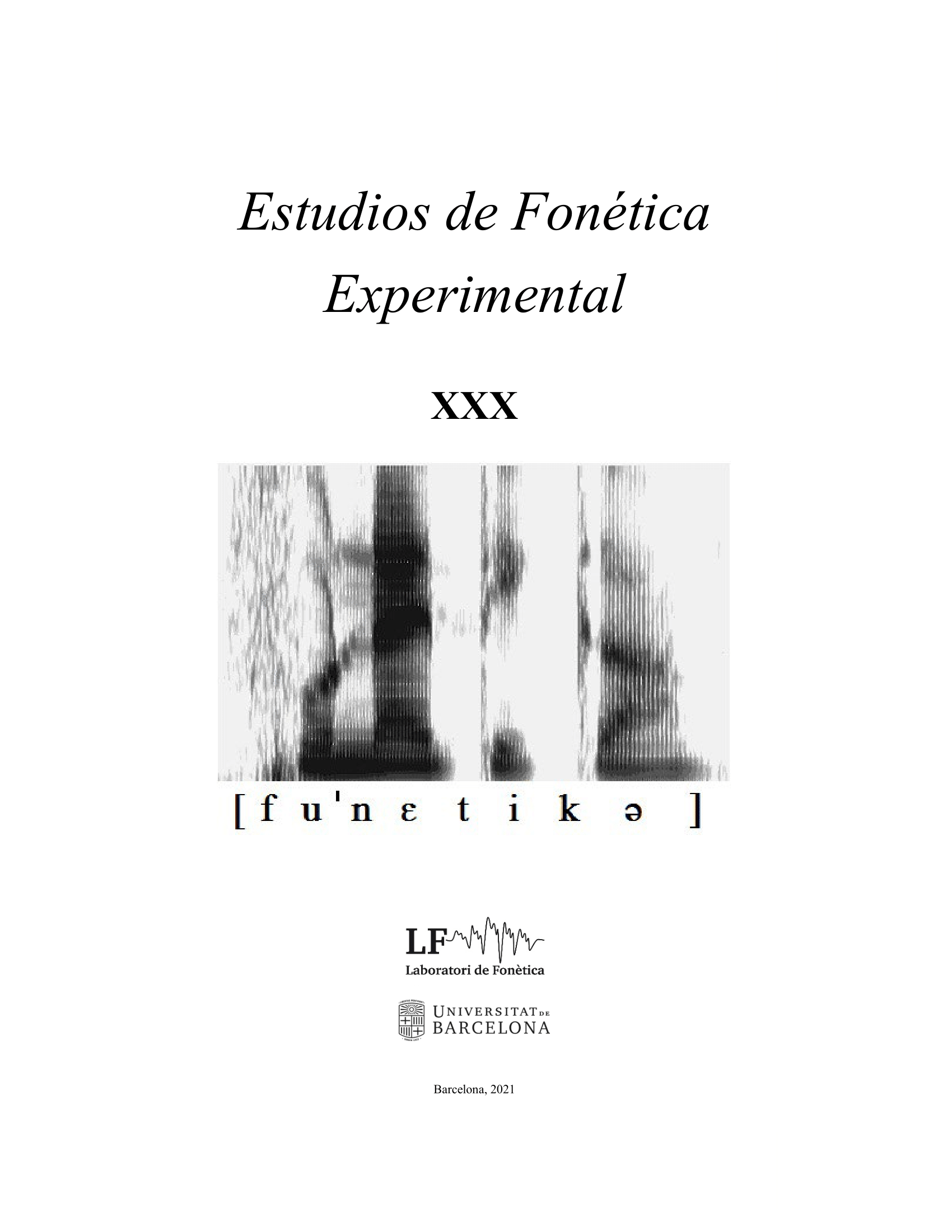Effects of attention on the production of Spanish consonants by SFL learners
DOI:
https://doi.org/10.1344/efe-2021-30-209-224Keywords:
Stops, Liquids, Spanish as a foreign language, AttentionAbstract
The aim of this paper is to analyse the production of Spanish stops /b, d, g, p, t, k/ and liquids /l, ɾ/ by Mandarin Chinese learners of Spanish (N=10). Two different tasks were used to elicit data: one induced a focus on stops and the other a focus on liquids. Realizations were categorized based on spectral manifestation, and acoustic parameter values between the two groups were compared. The results showed that attention exerts a significant influence on voiced stops and tap production: more inaccurate productions were observed when the learners did not focus on these phonemes. The data also pointed to considerable intra-speaker variation. Learners tended to produce realizations with longer durations in new phonemes: /b, d, g, ɾ/.
References
Almeida, M. y Dorta, J. (1993). Datos acústicos de las líquidas españolas. Revista de Filología, Homenaje a José Pérez Vidal, 97-110.
Asensi, L., Portolés, S. y del Río, A. (1997). Barra de explosión, VOT y frecuencia de las oclusivas sordas del castellano. Estudios de fonética experimental, 9, 221-242.
Blecua, B. (2001). Las vibrantes del español: Manifestaciones acústicas y procesos fonéticos. Tesis Doctoral en Filología Española. Bellaterra, España: Universidad Autónoma de Barcelona.
Boersma, P. y Weenink, D. (2017). Praat: Doing phonetics by computer, versión 6.0.36. 5. Consultado 27/04/2021 en http://www.praat.org.
Castañeda Vicente, M. L. (1986). El V.O.T de las oclusivas sordas y sonoras españolas. Estudios de Fonética Experimental, 2, 91-110.
Consejo de Europa. 2002. Marco Común Europeo de Referencia para las Lenguas: aprendizaje, enseñanza y evaluación. Madrid: Ministerio de Educación, cultura y deporte, Subdirección General de Cooperación Internacional y Grupo Anaya. Traducido por el Instituto de Cervantes.
Cortés Moreno, M. (2014). Dificultades lingüísticas del español para los estudiantes sinohablanes y búsqueda de soluciones motivadoras. SinoELE, (10), 173-208.
Duanmu, S. (2007). The Phonology of Standard Chinese (2.a ed.). Oxford: Oxford University Press. https://doi.org/10.1093/oso/9780199215782.001.0001
Flege, J. y Eefting, W. (1987). The production and perception of English stops by Spanish speakers of English. Journal of Phonetics, 15, 67-83. https://doi.org/10.1016/S0095-4470(19)30538-8
Flege, J. (1995). Second language speech learning: theory, findings and problems. En W. Strange, (Ed.), Speech Perception and Linguistic Experience: Theoretical and Methodological Issues in Cross-language Speech Research (pp. 233-272). Timonium, MD: York Press.
Gil, J. (2007). Fonética para profesores de español: de la teoría a la práctica. Madrid: Arco/Libros.
Ishihara, N. y Cohen, A.D. (2010). Teaching and Learning Pragmatics. Harlow UK: Longman.
Kang, O., Thomson, R. y Murphy, J. (Eds). (2017). The Routledge Handbook of Contemporary English Pronunciation. New York, NY: Routledge. https://doi.org/10.4324/9781315145006
Lemus Sandoval, J. E. (2002). VOT como rasgo distintivo de las consonantes oclusivas españolas e inglesas. Científica, 4, 49-58.
Lan, Y. y Wu, M. (2013). Application of Form-Focused Instruction in English Pronunciation: Examples from Mandarin Learners. Creative Education, 4(9), 29-34. https://doi.org/10.4236/ce.2013.49B007
Liberman, A., Delattre, P. D. y Cooper, F. S. (1958). Some cues for the distinction between voiced and unvoiced stops in initial position. Language and Speech, 1(3), 153-167. https://doi.org/10.1177/002383095800100301
Liu, Z. (2019). Análisis de las obstruyentes en chino y en español como L3. Estudio acústico y perceptivo para la categorización de errores. Tesis doctoral en Filología Española. Bellaterra, España: Universidad Autónoma de Barcelona.
Lin, Y.-H. (2007). The Sounds of Chinese. Cambridge: Cambridge University Press.
Loewen, S. (2015). Introduction to Instructed Second Language Acquisition. New York: Routledge. https://doi.org/10.4324/9780203117811
Machuca, M. J. (1997). Las obstruyentes no continuas del español: Relación entre las categorías fonéticas y fonológicas en habla espontánea. Tesis doctoral en Filología Española. Bellaterra, España: Universidad Autónoma de Barcelona.
Martínez Celdrán, E. (1993). La percepción categorial de /b-p/ en español basada en las diferencias de duración. Estudios de Fonética Experimental, 5, 223-239.
Martínez Celdrán, E. y Fernández Planas, A. M. (2007). Manual de fonética española. Articulaciones y sonidos del español. Barcelona: Ariel.
Quilis, A. (1981). Fonética acústica de la lengua española. Madrid: Gredos.
Quilis, A. (1993). Tratado de fonología y fonética españolas. Madrid: Gredos.
Quilis, A., Esgueva, M., Gutiérrez Araus, M. L. y Cantarero, M. (1979). Características acústicas de las consonantes laterales españolas. Lingüística Española Actual, 1(2), 233-344.
R CoreTeam. (2014). R: A Language and Environment for Statistical Computing. R Foundation for Statistical Computing. Viena, Austria.
Ruiz de Zarobe, L. y Ruiz de Zarobe, Y. (2013). Enseñar hoy una lengua extranjera. Barcelona: Octaedro.
Saito, K. (2014). Experienced teachers' perspectives on priorities for improved intelligible pronunciation: The case of Japanese learners of English. International Journal of Applied Linguistics, 24, 250-277. https://doi.org/10.1111/ijal.12026
Santamaría, E. (2015). Percepción y evaluación de la pronunciación del español como L2. Revista Española de Lingüística, 45(1), 175-207.
Schmidt, R. (2001). Attention. En P. Robinson (Ed.), Cognition and Second Language Instruction (pp. 3-32). Cambridge: Cambridge University Press. https://doi.org/10.1017/CBO9781139524780.003
Schmidt, R. (2010). Attention, awareness, and individual differences in language learning. En W. M. Chan, S. Chi, K. N. Cin, J. Istanto, M. Nagami, J. W. Sew, T. Suthiwan, & I. Walker, Proceedings of CLaSIC, (pp. 721-737). Singapore: National University of Singapore, Centre for Language Studies.
Shintani, N. (2016). Input-based Tasks in Foreign Language Instruction for Young Learners. Amsterdam: John Benjamins. https://doi.org/10.1075/tblt.9
Villamizar, T. (2002). Caracterización acústica de las consonantes oclusivas en el español de Venezuela. El parámetro duración (silencio-barra de explosión-VOT). Lengua y Habla, 7(1), 140-157.
Downloads
Published
How to Cite
Issue
Section
License
Copyright (c) 2021 Zhao Liu, María Jesús Machuca Ayuso

This work is licensed under a Creative Commons Attribution-NonCommercial-NoDerivatives 4.0 International License.
All articles published online by Estudios de Fonética Experimental are licensed under Creative Commons Attribution-NonCommercial-NoDerivs 4.0 International (CC BY-NC-ND 4.0 DEED), unless otherwise noted. Estudios de Fonética Experimental is an open access journal. Estudios de Fonética Experimental is hosted by RCUB (Revistes Científiques de la Universitat de Barcelona), powered by Open Journal Systems (OJS) software. The copyright is not transferred to the journal: authors hold the copyright and publishing rights without restrictions. The author is free to use and distribute pre and post-prints versions of his/her article. However, preprint versions are regarded as a work-in-progress version used as internal communication with the authors, and we prefer to share postprint versions.




